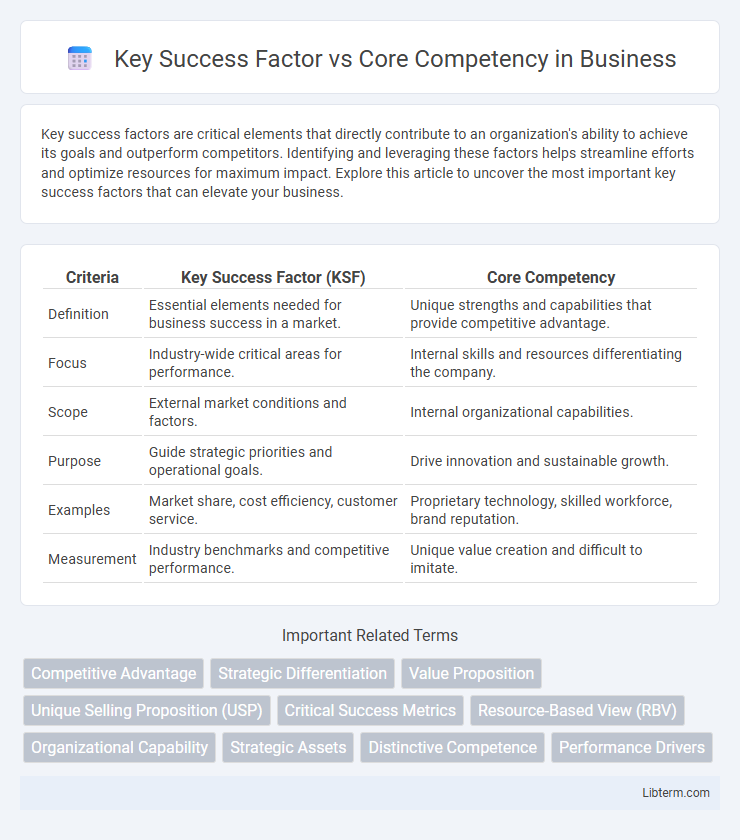Key success factors are critical elements that directly contribute to an organization's ability to achieve its goals and outperform competitors. Identifying and leveraging these factors helps streamline efforts and optimize resources for maximum impact. Explore this article to uncover the most important key success factors that can elevate your business.
Table of Comparison
| Criteria | Key Success Factor (KSF) | Core Competency |
|---|---|---|
| Definition | Essential elements needed for business success in a market. | Unique strengths and capabilities that provide competitive advantage. |
| Focus | Industry-wide critical areas for performance. | Internal skills and resources differentiating the company. |
| Scope | External market conditions and factors. | Internal organizational capabilities. |
| Purpose | Guide strategic priorities and operational goals. | Drive innovation and sustainable growth. |
| Examples | Market share, cost efficiency, customer service. | Proprietary technology, skilled workforce, brand reputation. |
| Measurement | Industry benchmarks and competitive performance. | Unique value creation and difficult to imitate. |
Defining Key Success Factors
Key Success Factors (KSFs) are the essential elements or conditions a company must achieve to compete effectively in its industry and satisfy customer demands. These factors often include market share, product quality, and operational efficiency, which directly influence business performance and profitability. Identifying and prioritizing KSFs enables organizations to focus resources on critical areas for sustaining competitive advantage.
Understanding Core Competencies
Core competencies are unique capabilities that provide a company with a competitive advantage and are deeply embedded within its operations, culture, and expertise. Understanding core competencies involves identifying the critical skills and technologies that differentiate a business in the marketplace and drive long-term value creation. These competencies align with strategic goals and fuel innovation, customer satisfaction, and sustainable growth.
Key Differences Between Key Success Factors and Core Competencies
Key Success Factors (KSFs) are the essential areas of activity that must be performed well to achieve competitive advantage and business objectives, often varying by industry and market conditions. Core Competencies represent unique capabilities or expertise that provide a company with a sustainable competitive edge, typically developed internally and difficult for competitors to replicate. The key difference lies in KSFs being critical external performance requirements, while Core Competencies are intrinsic organizational strengths driving long-term success.
The Role of Key Success Factors in Strategic Planning
Key Success Factors (KSFs) play a critical role in strategic planning by identifying the essential activities and conditions that must be achieved to ensure competitive advantage and organizational success. They guide decision-making processes and resource allocation, aligning internal capabilities with market demands and external environmental factors. Understanding KSFs enables businesses to focus on areas that drive performance, thereby enhancing long-term sustainability and growth.
How Core Competencies Drive Competitive Advantage
Core competencies are unique capabilities that enable a company to deliver exceptional value and differentiate itself in the marketplace. These competencies integrate specialized knowledge, technologies, and processes that underpin sustainable competitive advantage by creating products or services that are difficult for competitors to replicate. Key success factors are essential activities or conditions for industry success, but core competencies directly drive long-term strategic positioning and market leadership.
Identifying Key Success Factors in Your Industry
Identifying Key Success Factors (KSFs) in your industry involves analyzing critical elements that directly impact a company's ability to compete and thrive, such as market share, customer satisfaction, and operational efficiency. These factors vary by industry but often include innovation, cost leadership, quality control, and regulatory compliance. Understanding KSFs allows businesses to allocate resources effectively, enhance strategic planning, and gain a competitive advantage.
Building and Nurturing Core Competencies
Building and nurturing core competencies involves developing unique organizational skills and resources that provide sustainable competitive advantage and are difficult for competitors to replicate. Key success factors, on the other hand, are the essential elements or activities required to achieve business objectives and perform well in the market, often varying by industry. Focusing on core competencies enables companies to innovate, improve efficiency, and create value that aligns with key success factors, driving long-term growth and differentiation.
Case Studies: Success Factors vs Core Competencies in Leading Companies
Leading companies such as Apple and Amazon exemplify the distinction between key success factors and core competencies through their strategic case studies. Apple's core competency lies in innovative product design and user-centric technology ecosystems, while its key success factors include brand loyalty and premium retail experiences. Amazon's core competency is its advanced logistics and supply chain management, complemented by key success factors like customer-centric service and vast product variety, driving its market dominance.
Common Pitfalls in Differentiating Success Factors and Core Competencies
Common pitfalls in differentiating key success factors from core competencies include confusing external market requirements with internal capabilities, leading to misaligned strategic focus. Organizations often mistake key success factors, which are critical external conditions for competitive advantage, for core competencies, which are unique internal strengths that enable sustainable value creation. Failure to clearly distinguish these elements can result in ineffective resource allocation and missed opportunities for leveraging distinct skills to meet market demands.
Integrating Key Success Factors and Core Competencies for Sustainable Growth
Integrating Key Success Factors (KSFs) with Core Competencies enhances a company's ability to achieve sustainable growth by aligning critical operational strengths with market-driven success elements. This synergy enables organizations to optimize resource allocation, improve competitive advantages, and respond effectively to evolving industry demands. Prioritizing this integration fosters innovation, operational efficiency, and long-term value creation indispensable for enduring business performance.
Key Success Factor Infographic

 libterm.com
libterm.com